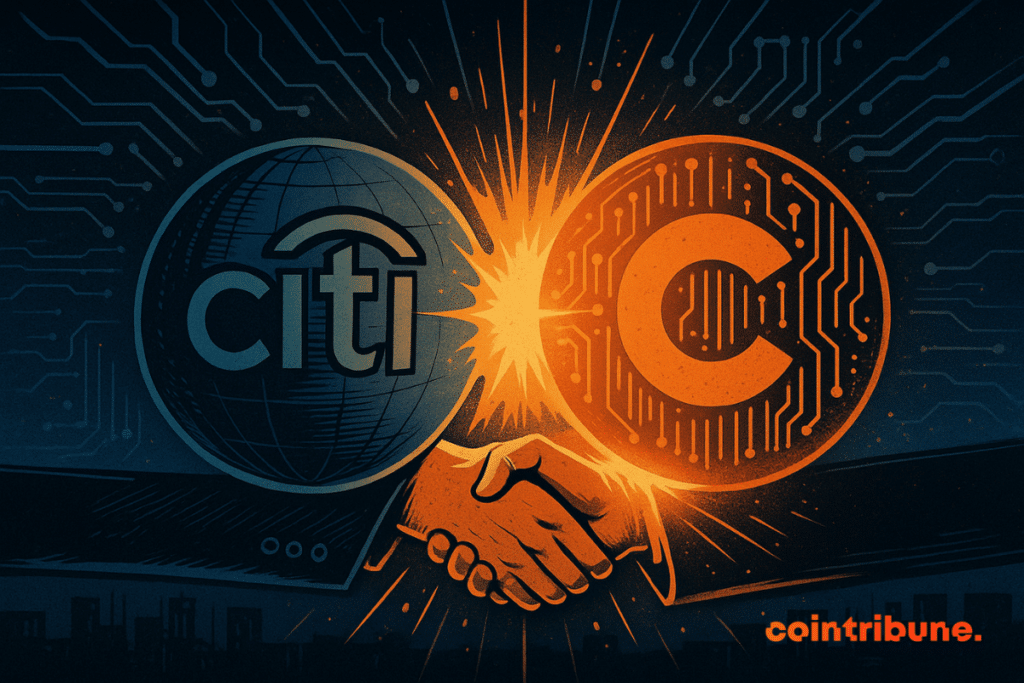Citi and Coinbase Partner to Launch Stablecoin Payments
U.S. bank Citi is taking a decisive step into digital payments by joining forces with Coinbase to pilot stablecoin transactions. The partnership marks a turning point in Wall Street’s embrace of blockchain-based money, following the U.S. GENIUS Act’s approval earlier this year. As the stablecoin market heads toward a projected $4 trillion valuation by 2030, Citi’s move positions it at the forefront of institutional adoption.

In brief
- Citi teams up with Coinbase to enable on-chain stablecoin payments, linking traditional banking with blockchain systems.
- The GENIUS Act fuels Wall Street’s push toward regulated stablecoin adoption and faster digital settlements.
- Citi predicts the stablecoin market will grow from $315B today to $4T by 2030, transforming global payments.
- Coinbase supports 250+ banks with crypto infrastructure for custody, payments, and institutional trading.
Citi Bets on Stablecoins as Key to the Future of Global Payments
Citi aims to become one of the first major banks to enable stablecoin payments—a move that could accelerate the integration of tokenized dollars into mainstream finance. According to Bloomberg, Citi’s collaboration with Coinbase focuses on streamlining the transfer of funds between traditional fiat systems and crypto networks for institutional clients.
Debopama Sen, Citi’s head of payments, said corporate clients increasingly demand faster, programmable, and more efficient settlement methods. She emphasized that clients want flexibility—round-the-clock access, conditional payments, and automation that current systems still can’t fully deliver.
Sen added that Citi is actively developing solutions to enable on-chain stablecoin payments for its clients. She explained that stablecoins are set to become a key driver in digital payments, helping expand the ecosystem and improve functionality for businesses using Citi’s services.
Citi is exploring solutions to enable onchain stablecoin payments for our clients in the near future. Stablecoins will be another enabler in the digital payment ecosystem and it’ll help grow the space, it’ll help grow functionality for our clients.
Debopama Sen
Citi’s pivot toward stablecoins aligns with its broader digital asset strategy. Just last month, the bank revised its outlook for the tokenized dollar market, forecasting a massive increase from $315 billion today to $4 trillion by 2030.
Wall Street Joins Citi in the Stablecoin Race
Momentum is building across Wall Street following the passage of the GENIUS Act, which introduces a federal regulatory framework for stablecoins set to take effect in 2027. In response, major banks are racing to develop their own solutions.
Citigroup now joins JPMorgan and Bank of America, both of which are exploring stablecoin-related services. Even JPMorgan CEO Jamie Dimon—once a vocal crypto critic—recently confirmed the bank’s plans to participate in stablecoin initiatives.
Investor confidence is also rising. Circle, issuer of the USDC stablecoin, went public earlier this year in a blockbuster debut, with shares soaring 167% on the first day. Circle’s valuation now sits around $35 billion, underscoring growing belief in regulated, dollar-backed digital assets.
Coinbase’s Expanding Role in Banking Infrastructure
Coinbase, Citi’s chosen partner, already supports more than 250 banks and financial institutions worldwide. Brian Foster, Coinbase’s global head of crypto-as-a-service, said the exchange has spent years refining its infrastructure to meet institutional standards. Banks, brokers, and fintechs increasingly seek access to Coinbase’s technology stack for services such as custody, staking, payments, spot trading, and derivatives.
Rising institutional adoption is being driven by three key trends: growing demand for stablecoin payments, increasing interest in tokenized assets, and the launch of crypto exchange-traded funds (ETFs). Since the GENIUS Act became law in July, stablecoin transaction volumes have risen sharply.
According to blockchain analytics firm Artemis, more than $10 billion flowed through stablecoins in August for payments and transfers—up from $6 billion in February and more than double the levels recorded in August 2024.
At the current pace, annual stablecoin payments could exceed $120 billion. Artemis data scientist Andrew Van Aken said businesses are shifting away from slow, costly international transfers toward blockchain-based payments that settle within minutes.
Key reasons companies are adopting stablecoin payments include:
- Faster cross-border settlement times, cutting waiting periods from days to minutes.
- Lower transaction costs compared to traditional wire or SWIFT systems.
- Greater transparency and auditability through on-chain verification.
- Seamless integration with programmable finance and smart contract systems.
- Improved liquidity management through 24/7 access to funds.
Van Aken noted that stablecoins are becoming increasingly attractive to companies because they offer yield potential and enable faster capital movement. In his view, these advantages are strengthening trust in digital dollars and driving their continued growth across global markets.
Maximize your Cointribune experience with our "Read to Earn" program! For every article you read, earn points and access exclusive rewards. Sign up now and start earning benefits.

James Godstime is a crypto journalist and market analyst with over three years of experience in crypto, Web3, and finance. He simplifies complex and technical ideas to engage readers. Outside of work, he enjoys football and tennis, which he follows passionately.
The views, thoughts, and opinions expressed in this article belong solely to the author, and should not be taken as investment advice. Do your own research before taking any investment decisions.